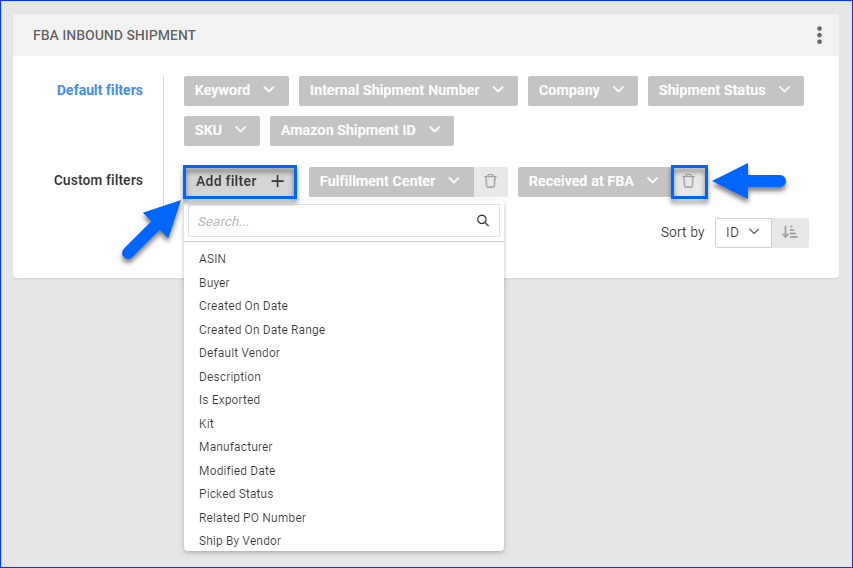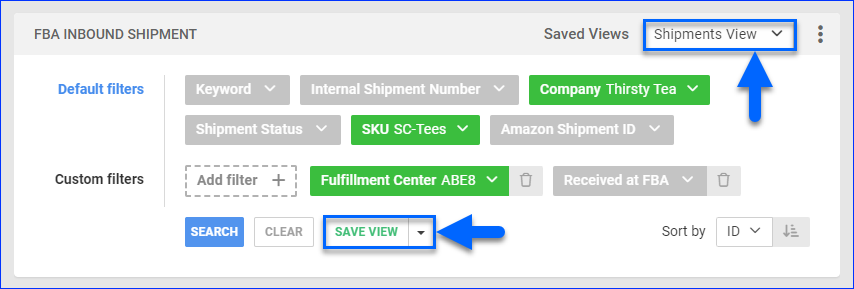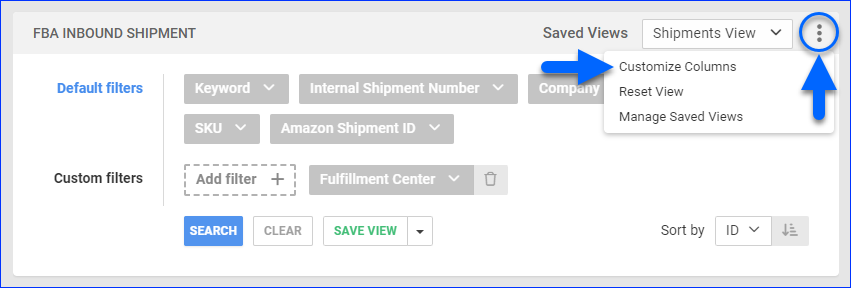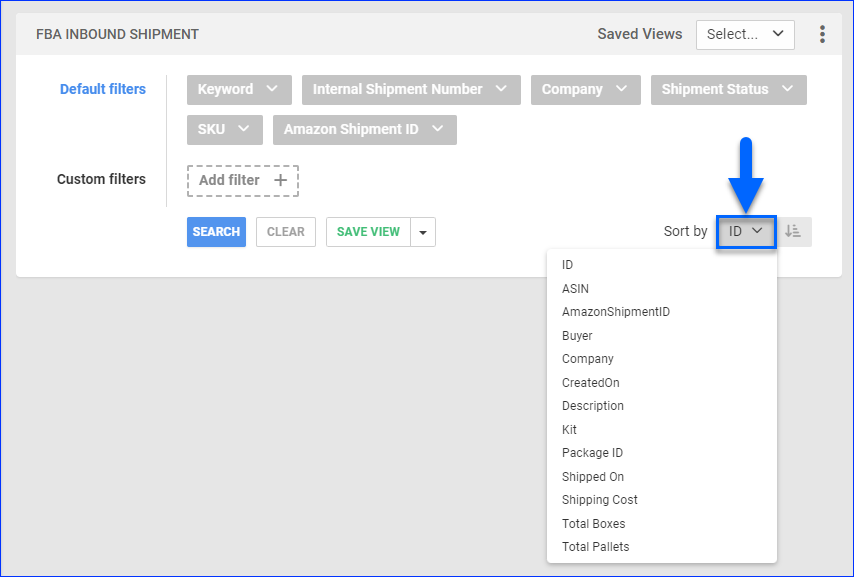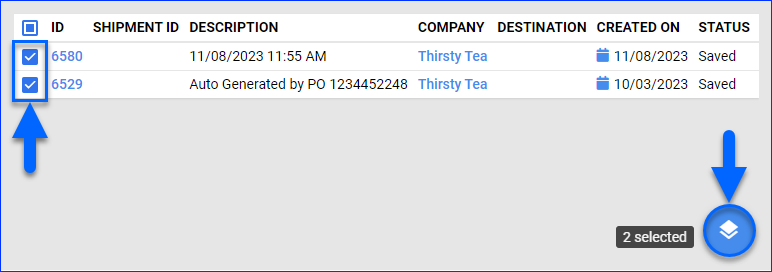Overview
The Manage FBA Shipments page in Sellercloud gives you quick and easy access to all your FBA Inbound Shipments. On this page, you can:
- View all FBA shipments in your Sellercloud account
- Use search filters to show only specific shipments
- Save your filters to effortlessly repeat searches
- Sort the list of shipments based on different columns
- Show or hide data columns from the list
- Perform individual and bulk actions related to shipments
Page Overview
To access your FBA inbound shipments, go to Inventory > Amazon Inbound Shipments > Manage FBA Shipments.
There are three components to the Manage FBA Shipments page:
- Search Filters – Search criteria used to get specific results. You can save searches for repeat use.
- Search Results – A list of FBA shipments matching your search filters. You can sort it differently and show or hide data columns.
- Actions – Actions related to FBA shipments.
Search Filters
Filters offer multiple-choice selection lists or allow you to enter specific values. Your choices build on each other. Each subsequent choice narrows the scope of your search results further and affects what the page displays. You can add as many filters as you like or none at all.
There are Default filters that are always displayed and Custom filters that you can display manually by clicking the Add filter button and selecting a filter from the list. To remove a custom filter from the page, click the Trash icon next to it.
After you click Search, each filter you apply gets highlighted in orange or green. If a filter is gray or not displayed at all, it’s not active. You can add or remove filters and search again at any time.
Once you have set up your filters, you can click Save View to save the search. Then, you can repeat the same search by selecting it from the Saved Views menu on the top right.
Search Results
The search results display a list of shipments matching your search criteria, with data columns showing various shipment details.
You can add, remove, and even reorder data columns. To do so, click the three dots icon at the top right and select Customize Columns.
Now you can:
- Reorder columns by dragging them vertically in the list
- Hide columns by clicking the Trash icons
- Add columns by clicking Add column
You can also sort the shipments list in a different order based on a specific column using the Sort by drop-down menu.
Actions
The Manage FBA Shipments page also has actions for shipment management.
The Actions icon is located on the bottom right of the page. By default, it is a green plus icon that allows you to create a new shipment. When you select shipments from the search results by checking the boxes to their left, the icon turns blue. Once it’s blue, you can click it to manage all selected shipments.
You can use the search to find a specific action quickly. Click the Star icon next to any frequently used action to pin it to the top of the actions list for quick access.
Some of these actions will display a notification at the bottom of the screen when used, telling you that a Queued Job has been created. You can click the link to the queued job to view it. Make sure to refresh the page to update the job’s Status.
Descriptions
This section lists and defines all available elements on the Manage FBA Shipments page. This includes the search filters, the columns that display shipment data and sort results, and the actions you can perform on selected shipments.
Filter Descriptions
See the following lists for all Default/Custom filters and their descriptions.
Default Filters
| Filter | Description |
| Keyword | Show only shipments with specific text in their details, such as in their ID, Description, or SKU. |
| Internal Shipment Number | Show only shipments that match specific Sellercloud identification numbers. Corresponds to the ID column. |
| Company | Show only shipments associated with specific Companies. |
| Shipment Status | Show only shipments matching one or more shipment statuses. |
| SKU | Show only shipments that include specific SKUs. |
| Amazon Shipment ID | Show only shipments that match a specific Amazon identification number. |
Custom Filters
| Filter | Description |
| ASIN | Show only shipments that include items with a specific ASIN. |
| Brand | Show shipments that contain SKUs of a specific Brand. |
| Buyer | Show only shipments containing items associated with a specific Purchaser. |
| Created On Date | Show only shipments created within a custom date range. |
| Created On Date Range | Show only shipments created within a predefined date range. |
| Default Vendor | Show only shipments containing items associated with a specific default Vendor. |
| Description | Show only shipments that contain specific text in their description. |
| Fulfillment Center | Show shipments based on their destination Amazon fulfillment center. |
| Is Exported | Show shipments based on whether they have been marked as exported from the system or not. |
| Kit | Show shipments based on whether they contain Kit Products or not. |
| Manufacturer | Show only shipments containing items made by a specific Manufacturer. |
| Modified Date | Show only shipments that were last updated within a specific date range. |
| Picked Status | Show shipments based on the items’ Picking status. |
| Received at FBA | Show shipments based on their receiving status at the Amazon fulfillment center. |
| Related PO Number | Show only shipments that are associated with a specified Purchase Order number. |
| Ship By Vendor | Show only shipments that are shipped directly by a specific vendor. |
| Ship From Warehouse | Show only shipments originating from a specific warehouse. |
| Shipped Date | Show only shipments that were shipped within a specific date range. |
| Tracking Number | Show only shipments matching a specific tracking number. |
Column Descriptions
See the following list for all data columns and their descriptions.
| Column | Description |
| Amazon Shipment ID | The shipment’s unique Amazon-specific identification number. |
| Description | A brief text summary of the shipment or its contents. |
| Company | The Company associated with the shipment. |
| Destination Fulfillment Center | The Amazon facility where the shipment is being sent. |
| Created On | The date when the shipment was created. |
| Shipment Status | The shipment status indicates the current state of the shipment, such as On Order, In Transit, or Delivered. |
| From Warehouse Name | The name of the warehouse from which the shipment is being sent to Amazon. |
| SKUs | The total number of SKUs in the shipment. |
| Units | The total number of product units in the shipment. |
| Tracking Number | The number provided by the carrier to track the shipment’s progress from the warehouse to the fulfillment center. |
| Related PO Number | The unique identification number of the Purchase Order associated with the shipment. |
| ASIN | The ASIN of an item in the shipment. If the shipment contains more line items, they will be counted next to the ASIN. |
| Buyer | The employee listed as the Purchaser of the first item listed in the shipment. |
| Kit | The SKU of the first Kit Product listed in the shipment. If the shipment contains more kits, this will be indicated by a number next to the SKU. |
| Package ID | A unique identifier for each individual package within the shipment. If the shipment contains more packages, this will be indicated by a number next to the first package ID. |
| Priority | The priority indicates the urgency or level of importance assigned to the shipment. |
| Shipped On | The date when the shipment was sent from the shipping warehouse. |
| Shipping Cost | The total cost incurred for sending the shipment to an Amazon fulfillment center. |
| Total Boxes | The number of boxes included in the shipment. |
| Total Pallets | The number of pallets included in the shipment. |
| Units Picked | The number of individual items that have been Picked from inventory and are ready for packing and shipping. |
You can show or hide these columns by clicking the three dots in the top right and selecting Customize Columns. To sort results based on these columns, use the Sort by menu.
Action Descriptions
See the following list for all actions and their descriptions.
| Action | Description |
| Merge FBA Shipments | Combine the products in the selected shipments into a single shipment for more efficient processing and tracking. |
| Export to Excel | Generate and download an Excel spreadsheet containing the details of the selected shipments for external analysis or record-keeping. |
| Export Shipments | Export the details of the selected shipments in a default format or by using an FBA shipment export plugin for use in other systems or reporting. |
| Reset Preview | Clear any changes applied to the preview of the selected shipments, returning it to its default state and acknowledging that the selected shipments are abandoned shipment defects. These will appear in your shipment queue as Cancelled and will be subject to Inbound defect fees. |
| Query Status | Check and update the current status of the selected shipments based on the latest information available on Amazon. |
| Print Invoice | Generate and print invoices for the selected shipments. |
| Create New FBA Inbound Shipment | Create a new inbound shipment. |
| Connect To FBA | Establish a connection to Amazon’s system for the selected shipments, allowing for direct management and updates from Sellercloud. |
| Disconnect From FBA | Sever the connection to Amazon’s system for the selected shipments, preventing further updates or management through Sellercloud. |
| Delete Selected | Permanently remove the selected shipments. You can’t undo this action. |
| Cancel Selected | Cancel the processing of the selected shipments, setting their status to Cancelled, and halting any further actions related to those shipments. |
